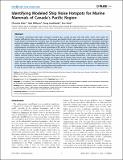Files in this item
Identifying modeled ship noise hotspots for marine mammals of Canada's Pacific region
Item metadata
| dc.contributor.author | Erbe, Christine | |
| dc.contributor.author | Williams, Rob | |
| dc.contributor.author | Sandilands, Doug | |
| dc.contributor.author | Ashe, Erin | |
| dc.date.accessioned | 2014-05-08T14:01:01Z | |
| dc.date.available | 2014-05-08T14:01:01Z | |
| dc.date.issued | 2014-03-05 | |
| dc.identifier | 116748860 | |
| dc.identifier | edcb2a2b-657f-4186-8553-6eb070d18007 | |
| dc.identifier | 000332479400029 | |
| dc.identifier | 84897142661 | |
| dc.identifier | 000332479400029 | |
| dc.identifier.citation | Erbe , C , Williams , R , Sandilands , D & Ashe , E 2014 , ' Identifying modeled ship noise hotspots for marine mammals of Canada's Pacific region ' , PLoS One , vol. 9 , no. 3 , 89820 . https://doi.org/10.1371/journal.pone.0089820 | en |
| dc.identifier.issn | 1932-6203 | |
| dc.identifier.uri | https://hdl.handle.net/10023/4728 | |
| dc.description | RW was supported by a Marie Curie International Incoming Fellowship within the 7th European Community Framework Programme (Project CONCEAL, FP7, PIIF-GA-2009-253407). These analyses were funded by a grant to RW and EA from Marisla Foundation. | en |
| dc.description.abstract | The inshore, continental shelf waters of British Columbia (BC), Canada are busy with ship traffic. South coast waters are heavily trafficked by ships using the ports of Vancouver and Seattle. North coast waters are less busy, but expected to get busier based on proposals for container port and liquefied natural gas development and expansion. Abundance estimates and density surface maps are available for 10 commonly seen marine mammals, including northern resident killer whales, fin whales, humpback whales, and other species with at-risk status under Canadian legislation. Ship noise is the dominant anthropogenic contributor to the marine soundscape of BC, and it is chronic. Underwater noise is now being considered in habitat quality assessments in some countries and in marine spatial planning. We modeled the propagation of underwater noise from ships and weighted the received levels by species-specific audiograms. We overlaid the audiogram-weighted maps of ship audibility with animal density maps. The result is a series of so-called "hotspot'' maps of ship noise for all 10 marine mammal species, based on cumulative ship noise energy and average distribution in the boreal summer. South coast waters (Juan de Fuca and Haro Straits) are hotspots for all species that use the area, irrespective of their hearing sensitivity, simply due to ubiquitous ship traffic. Secondary hotspots were found on the central and north coasts (Johnstone Strait and the region around Prince Rupert). These maps can identify where anthropogenic noise is predicted to have above-average impact on species-specific habitat, and where mitigation measures may be most effective. This approach can guide effective mitigation without requiring fleet-wide modification in sites where no animals are present or where the area is used by species that are relatively insensitive to ship noise. | |
| dc.format.extent | 10 | |
| dc.format.extent | 1790498 | |
| dc.language.iso | eng | |
| dc.relation.ispartof | PLoS One | en |
| dc.subject | Underwater hearing sensitivity | en |
| dc.subject | Dolphins tursiops-truncatus | en |
| dc.subject | Evoked-potential audiometry | en |
| dc.subject | Porpoise phocoena-phocoena | en |
| dc.subject | Cumulative sound exposure | en |
| dc.subject | Seals phoca-vitulina | en |
| dc.subject | Whales orcinus-orca | en |
| dc.subject | Signal duration | en |
| dc.subject | Tonal signals | en |
| dc.subject | Delphinapterus-leucas | en |
| dc.subject | QL Zoology | en |
| dc.subject | SDG 14 - Life Below Water | en |
| dc.subject.lcc | QL | en |
| dc.title | Identifying modeled ship noise hotspots for marine mammals of Canada's Pacific region | en |
| dc.type | Journal article | en |
| dc.contributor.institution | University of St Andrews. School of Biology | en |
| dc.identifier.doi | 10.1371/journal.pone.0089820 | |
| dc.description.status | Peer reviewed | en |
This item appears in the following Collection(s)
Items in the St Andrews Research Repository are protected by copyright, with all rights reserved, unless otherwise indicated.

